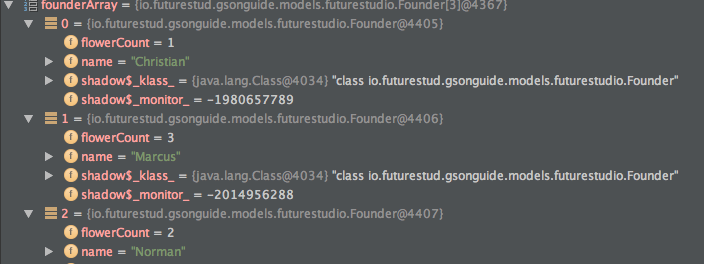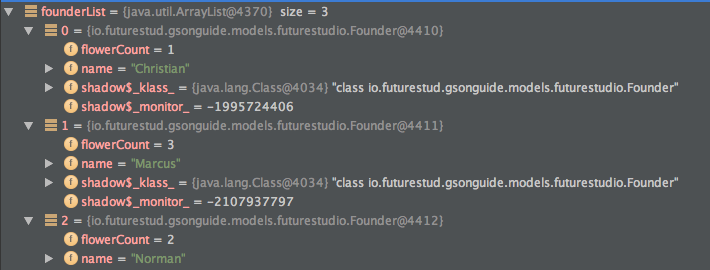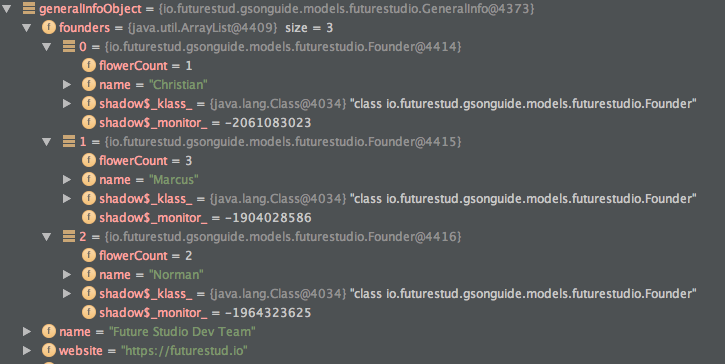How to Read Multiple Json Objects in Java
Welcome back to another blog post in our Gson series. Afterward reviewing the basics of Gson, model annotations and mapping of nested objects, nosotros'll get on to a core feature: mapping of Arrays and Lists. Near every data model out there utilizes some form of listing. Fortunately, Gson makes it really like shooting fish in a barrel to deal with them.
As yous know, we're publishing a whole series about Gson. If you lot're interested in another topic, check out our serial outline:
Gson Series Overview
Departure Between Arrays and Lists
Before we go into specific (de)serialization examples, we want to examine the 2 Java structures Arrays and Lists. The Coffee implementation is significantly different and either one has its advantages. What you're going to employ in your apply case depends on the software requirements and at to the lowest degree partly your personal taste. The interesting thing when it comes to mapping list or array structures to JSON: it doesn't matter.
In the JSON information format, there are no lists or arrays. Yes, the Coffee implementations make a huge difference between them, just on a high level they represent the exact same data in a list form. In the rest of the blog mail service, we'll name them object lists, but on the Java side they tin can be either. If this is a bit confusing, don't worry, it'll exist much clearer after a few examples.
Data Serialization of Arrays/Lists
Think our restaurant model from the previous weblog postal service most nested objects? It'southward time that the restaurant also includes a carte du jour, isn't information technology? We want to know what yummy foods are offered for which prices. A restaurant menu tin can be structured as a list of card items. One particular is exactly 1 option a customer can order. In our unproblematic eating house, each item has a description and a price.
Hint: we'll keep it piece of cake and not deal with bill of fare categories, combos or side dishes. Information technology'southward manifestly not a complete model, so don't use it for your commercial Restaurant app …
If we call back near the concrete Java model implementation, nosotros'll get something close to this:
public class RestaurantWithMenu { Cord name; List<RestaurantMenuItem> carte; //RestaurantMenuItem[] menu; // alternative, either one is fine } public class RestaurantMenuItem { String clarification; float price; } Just with nested objects the mode Java handles the objects is dissimilar than JSON is able to. Java can go along them every bit separate classes and just hold a reference to the List or Assortment implementation. JSON needs to continue the lists equally a local, nested lists. That means on a high level we would expect on the JSON side something similar this:
{ "proper noun": "Future Studio Steak House", "menu": [ ... ] } Similar to nested objects, nosotros don't have a direct value for menu. Instead, JSON declares that a list of objects is coming by wrapping the value with []. Every bit mentioned above, there is no difference if this is an array or a listing. In the JSON data structure information technology looks identical.
The content of the card are a bunch of objects. In our example, they're the restaurant's menu items. Let's run Gson to come across how a complete JSON would look similar.
Nosotros hope you lot know the drill by now. Get your Java objects, initialize Gson so permit Gson create the matching JSON:
Listing<RestaurantMenuItem> menu = new ArrayList<>(); menu.add together(new RestaurantMenuItem("Spaghetti", 7.99f)); menu.add(new RestaurantMenuItem("Steak", 12.99f)); carte.add(new RestaurantMenuItem("Salad", 5.99f)); RestaurantWithMenu eating place = new RestaurantWithMenu("Futurity Studio Steak Business firm", menu); Gson gson = new Gson(); String restaurantJson = gson.toJson(restaurant); The restaurantJson contains the following content:
{ "carte du jour": [ { "description": "Spaghetti", "price": seven.99 }, { "description": "Steak", "price": 12.99 }, { "clarification": "Salad", "price": 5.99 } ], "name": "Future Studio Steak House" } Equally always, the order is a little surprising, but the listing comes commencement since the menu is alphabetically earlier the name. Besides the order, everything else looks like expected. The list (indicated past […]) contains multiple objects (indicated each past {…}).
Just we're not always sending lists of information nested in a single object, like nosotros've washed above. Sometimes nosotros just want to ship a list. Of form, Gson too supports the JSON serialization of lists. For example, if we would just serialize the card items like this:
List<RestaurantMenuItem> carte = new ArrayList<>(); bill of fare.add(new RestaurantMenuItem("Spaghetti", 7.99f)); menu.add(new RestaurantMenuItem("Steak", 12.99f)); menu.add(new RestaurantMenuItem("Salad", five.99f)); Gson gson = new Gson(); String menuJson = gson.toJson(menu); This would lead to:
[ { "description": "Spaghetti", "price": seven.99 }, { "clarification": "Steak", "price": 12.99 }, { "clarification": "Salad", "toll": 5.99 } ] Allow us point out the critical deviation: the first graphic symbol of the JSON is a [, which indicates that a listing of objects is coming! So far, we've only looked at objects, which showtime with a {. You should endeavour to memorize that deviation correct away. Y'all'll need it all the time and right away in the side by side section, if yous keep reading.
Information Deserialization of Arrays/Lists
In this second part we'll go through the deserialization. In other words how we can use Gson to map from lists in a JSON construction to Java objects. In the previous example, nosotros've looked at the important difference if the list is the root or nested in an object in the JSON information.
Lists as Root Object
And so allow's do an do. In example nosotros at Future Studio volition start our ain API, we'll also provide an endpoint GET /founders. This endpoint would return the three of the states with our name and a flowerCount, which displays the corporeality of plants on our desk. So has the following JSON a list as root?
[ { "name": "Christian", "flowerCount": i }, { "proper noun": "Marcus", "flowerCount": three }, { "name": "Norman", "flowerCount": 2 } ] Yes, you lot're correct. The imaginary GET /founders endpoint returns a listing direct. The JSON starts and ends with a []. Y'all're also correct that Marcus likes to piece of work at a green jungle of a desk-bound.
Then how practice we map this with Gson to Java objects? The first stride is to create our model:
public class Founder { String name; int flowerCount; } The second step depends on you. Do you want to utilise Lists or Arrays as your type?
Arrays
If you lot desire to employ Arrays, it's pretty simple. You lot can directly use the fromJson() part as nosotros've washed before and pass the model class equally an array similar gson.fromJson(founderGson, Founder[].class);.
String founderJson = "[{'name': 'Christian','flowerCount': 1}, {'name': 'Marcus', 'flowerCount': 3}, {'proper name': 'Norman', 'flowerCount': 2}]"; Gson gson = new Gson(); Founder[] founderArray = gson.fromJson(founderJson, Founder[].class); This will create a Coffee assortment of founder objects, which have the attributes mapped correctly:

Lists
A lot of developers nowadays prefer Java Lists due to the wider range of methods. Unfortunately, yous cannot straight pass a List<Founder> to Gson. In gild for Gson to understand the List construction correctly, you've to figure out its Blazon. Luckily, at that place is a Gson class TypeToken to help y'all in finding the correct Blazon for pretty much any class configuration. For our Founder class in an ArrayList, it'd look like this:
Type founderListType = new TypeToken<ArrayList<Founder>>(){}.getType(); You lot can use the result of the statement as the type for the Gson call:
String founderJson = "[{'proper name': 'Christian','flowerCount': 1}, {'proper name': 'Marcus', 'flowerCount': three}, {'name': 'Norman', 'flowerCount': 2}]"; Gson gson = new Gson(); Type founderListType = new TypeToken<ArrayList<Founder>>(){}.getType(); Listing<Founder> founderList = gson.fromJson(founderJson, founderListType); This works just every bit well as the Array approach:

In the end information technology's upward to your personal preference and the use case if you map your data to an Array or a Listing. Let'south await at ane more than topic: how to deserialize a list when information technology's nested in an object:
Lists equally Office of an Object
We've extended our imaginary Future Studio API with another, general endpoint GET /info. It returns more than than just the founder data:
{ "name": "Time to come Studio Dev Team", "website": "https://futurestud.io", "founders": [ { "name": "Christian", "flowerCount": 1 }, { "name": "Marcus", "flowerCount": three }, { "proper noun": "Norman", "flowerCount": 2 } ] } Nosotros promise you know the drill now. First, we've to write an appropriate model for the JSON response. Nosotros can re-use our Founder grade from the previous section:
public class GeneralInfo { String proper name; String website; List<Founder> founders; } The advantage of the list nested in an object is the simple Gson call without whatever TypeToken handling. We can directly pass the course:
String generalInfoJson = "{'name': 'Hereafter Studio Dev Team', 'website': 'https://futurestud.io', 'founders': [{'name': 'Christian', 'flowerCount': one }, {'name': 'Marcus','flowerCount': 3 }, {'proper noun': 'Norman','flowerCount': 2 }]}"; Gson gson = new Gson(); GeneralInfo generalInfoObject = gson.fromJson(generalInfoJson, GeneralInfo.grade); This will pb to a complete object:

Of course, you could change the GeneralInfo form to use Founder[] array instead of List<Founder>. The Gson phone call would stay the same though.
Note: did you notice that Gson has no problems with both, the GeneralInfo and the Founder model having a name property? It'll serialize and deserialize information technology without any problems. Awesome!
Lists Nested in Lists
If you're wondering, Gson has no problems with Lists nested in Lists. For example, the following model would be no problem:
public class GeneralInfo { String name; Cord website; Listing<FounderWithPets> founders; } The FounderWithPets class is at present a little extended with a list of pets:
public class FounderWithPets { String name; int flowerCount; List<Pet> pets; } The Pet class on the other hand includes a listing of toys:
public class Pet { Cord name; List<Toy> toys; } The Toy class includes … okay, nosotros finish now. Nosotros hope this brings the indicate across: you tin can wrap lists in lists (even more than once) without whatsoever problems. Gson handles the serialization and deserialization like a champ.
Nonetheless, Gson can only handle lists of objects with some consistency. If the objects are completely random and arbitrary, Gson will not be able to map them! A list of polymorphic objects is not a problem though.
Outlook
In this blog post you've learned how Gson is able to map List (or Assortment) data without whatsoever problems. Gson is flexible and accepts List and Array implementations on the Java side. You need to learn how to recognize from the JSON structure if the list is the root or nested in an object. You likewise learned how to gear up a different deserialization from JSON to a Coffee Assortment or a Java List.
If you've feedback or a question, let us know in the comments or on twitter @futurestud_io.
Make it rock & relish coding!
johnsonhisibut1941.blogspot.com
Source: https://futurestud.io/tutorials/gson-mapping-of-arrays-and-lists-of-objects

0 Response to "How to Read Multiple Json Objects in Java"
Post a Comment